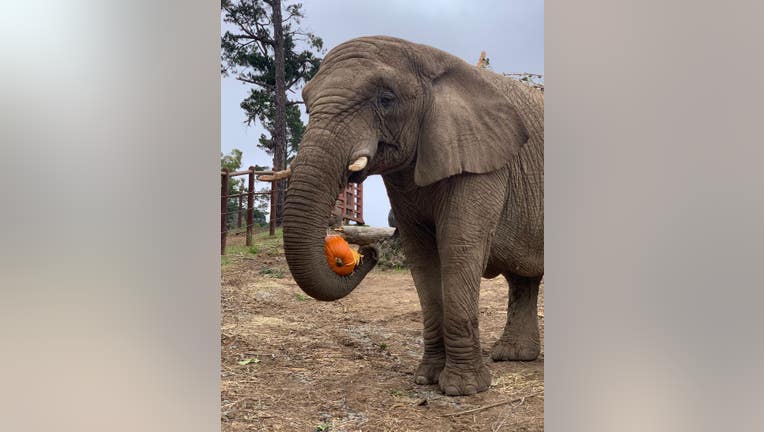Lisa the elephant receiving stem-cell infusion therapy at Oakland Zoo

Lisa the Elephant. Photo courtesy Oakland Zoo's Keeper Marisa.
OAKLAND, Calif. - One of the elephants at Oakland Zoo is receiving cutting-edge treatment in the form of stem-cell infusions to help with the animal's arthritis.
Lisa, a 45-year-old female African elephant, received the first treatment in October, according to Dr. Ryan Sadler, senior veterinarian at Oakland Zoo, who runs clinical operations.
Zoo officials said Lisa has reached her senior years and because of her arthritis, was not lying down and that the pads on her feet were thinning. The majestic animal weighs 8,500 pounds and has developed lesions on her toes. The lesions are due to Lisa putting more weight on her feet. Dr. Sadler said elephants can definitely seem fatter in zoos than in the wild.
Zoo officials said stem cells grown from a healthy elephant were infused into Lisa's bloodstream to combat her worsening arthritis, a condition she's had for more than 20 years.
"Stem cells can come from fetal or umbilical tissue, and it can come from other places," Sadler said. In Lisa's case, they come from another elephant's tusk. "The tusk is a modified incisor that grows throughout their life."
Dr. Sadler elaborates on this highly-specialized process on how the stem cells are attracted to and migrate to areas of inflammation. For Lisa, the treatments are helping her form new cartilage.
"It’s an IV infusion. Elephants get it in a vessel in the back of the ear. The beauty is, they get it into their veins. It’s an injection that takes five minutes to do. Quick and easy. We don’t want them to be scared," Sadler said.
He compared the process to what we think of as an outpatient procedure; done in about an hour with light sedation.
Dr. Sadler collaborated with arthritis specialist Dr. Valerie Johnson from Michigan State University to perform this therapy. The two have collaborated using this medical technology before on two elephants at other zoos suffering from arthritis.
Dr. Johnson has more specific experience in this area and has done around nine elephants in total. Sadler said it works in about 50% of the cases. He's also worked on antelope, cheetah, and tigers, who have seen benefits of stem-cell infusions.
"There’s always risk," said Sadler. Things to look out for include; adverse reactions and negative side effects. "What are the species that are going to respond? Part of the research is why do some animals respond and some don’t."
Fortunately in Lisa's case, everything went great with the procedure. "She was back with friend, Donna by the afternoon," said Sadler. Donna being another elephant at the zoo. The vets monitored Lisa for the first month after the treatment to see the effects. Sadler said her mobility and attitude, is all better. Due to the positive response, she'll be due for another infusion at the end of January.

Lisa the Elephant. Photo courtesy Oakland Zoo's Keeper Marisa.
As for the cost, the treatment is connected to ongoing research. "It is an expensive process. It's diffused through different research budgets," Sadler said. "Oakland Zoo pays for Dr. Johnson to fly out and veterinarians donate their time." However, Sadler is salaried staff at the zoo.
The transport of the liquid used in the process is also costly. But it's a collaboration that pays off as they share other research materials, such as tissues in order to grow stem cells.
Lisa is in the middle to early stages of osteoarthritis, which made her a good candidate for the procedure, Sadler said. "We didn’t want to wait too long." She was becoming less responsive to physical therapy. Sadler said this species of elephant can live up to 60 to 70 years under managed care. They don't live as long in Sub-Saharan Africa, especially during drought.
We had previously reported on another procedure Lisa had done over the summer when she had an ulcer removed from her eye. At that time, we also learned the fun fact that elephants can sleep standing up, but that they generally lie down for a few hours to rest their joints.
MORE: Lisa the elephant shows signs of improvement at Oakland Zoo
Over the summer, Lisa needed drops for her eye every two hours. "She was great for all of that. She’d come to the fence every time," said Sadler. Despite her willingness, she'd be given treats as a bonus. "It was soothing."
He said the treatments the animals receive under the zoo's care is a sign of their bond. "She’s still a sassy old lady, don’t get me wrong. You can’t make an elephant do anything." But he says they know it makes them feel better.
As the weather gets cold, the animals are now transitioning into winter mode. "It does get surprisingly cold in African Savanna," said Sadler. Zoo officials said Lisa and the other elephants now sleep inside a heated elephant barn at night, which helps ease Lisa’s arthritis.
She has access to the habitat every day and like all the elephants, has a choice on what they like to do. We're told Lisa loves the pool and warming up with Epsom salt soaks.
Lisa is open to visitors during the zoo's normal hours. You might catch her snacking on a pumpkin. They say she's very active when she knows they're around.

